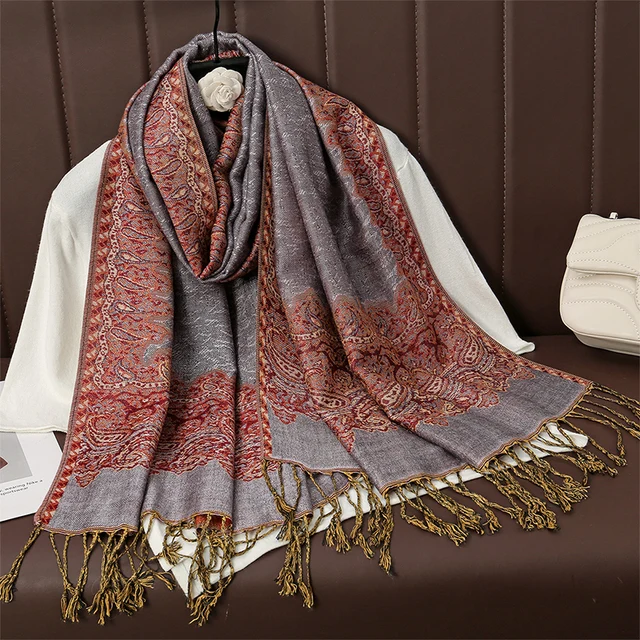
Introduction
These are more than just a cozy layer against the cold; they are a versatile fashion accessory that can elevate any winter outfit. From chunky knits to delicate cashmere, these come in a variety of materials, styles, and designs. This comprehensive guide explores the different types of winter scarves, their materials, how to style them, and tips for care and maintenance.
The Importance of Winter Scarves
These serve multiple purposes, making them an indispensable part of any winter wardrobe:
- Warmth: The primary function of a winter scarf is to provide warmth by trapping heat around the neck and chest, essential for keeping comfortable in cold weather.
- Protection: Scarves protect against harsh winds, snow, and rain, shielding the sensitive skin of the neck and face from the elements.
- Fashion Statement: A well-chosen scarf can add a pop of color, texture, and style to any outfit, making it a versatile accessory that enhances personal style.
Types of Winter Scarves
Winter scarves come in a variety of styles, each with its unique appeal and functionality:
- Classic Long Scarves:
- Description: These are the most traditional type of scarf, usually long and rectangular, allowing for multiple wrapping and styling options.
- Styling: Can be worn in various ways, such as wrapped once or multiple times around the neck, draped over the shoulders, or knotted at the front.
- Infinity Scarves:
- Description: Also known as loop or circle scarves, these scarves are continuous loops without ends.
- Styling: Easily worn by doubling over the head and wrapping around the neck, offering a snug fit and stylish look.
- Snoods:
- Description: Similar to infinity scarves but often thicker and designed to cover the neck and head.
- Styling: Pulled over the head and worn around the neck, providing extra warmth and protection for both the neck and head.
- Blanket Scarves:
- Description: Oversized scarves that are large enough to be used as a blanket, often square or rectangular.
- Styling: Worn draped over the shoulders, wrapped multiple times around the neck, or styled as a shawl or cape.
- Pashmina Scarves:
- Description: Made from fine cashmere wool, pashmina scarves are known for their softness, warmth, and luxurious feel.
- Styling: Can be worn as a scarf or a wrap, perfect for both casual and formal occasions.
- Knit Scarves:
- Description: Made from various yarns, knit scarves can be chunky or fine, offering different levels of warmth and texture.
- Styling: Chunky knits are great for casual looks, while finer knits can be dressed up or down.
Materials Used in Winter Scarves
The material of a winter scarf greatly affects its warmth, feel, and style:
- Wool:
- Warmth and Durability: Wool is one of the warmest materials, providing excellent insulation and durability.
- Types of Wool: Includes merino wool, alpaca, and cashmere, each with different textures and levels of softness.
- Cashmere:
- Softness and Luxury: Known for its incredible softness and warmth, cashmere is a premium choice for winter scarves.
- Lightweight Warmth: Provides excellent insulation without the bulk, making it ideal for layering.
- Fleece:
- Synthetic Warmth: Fleece is a synthetic material that offers warmth and moisture-wicking properties.
- Affordable and Durable: Often more affordable than wool and cashmere, fleece scarves are durable and easy to care for.
- Acrylic:
- Versatility and Affordability: Acrylic is a versatile and affordable material that can mimic the look and feel of wool.
- Easy Care: Machine washable and durable, making it a practical choice for everyday wear.
- Silk and Satin:
- Elegance and Comfort: Silk and satin scarves add a touch of elegance and can be worn for formal occasions.
- Lightweight Layering: Though not as warm as wool or cashmere, they can be layered with other scarves for added warmth.
Styling Winter Scarves
A winter scarf can be styled in numerous ways to complement different outfits and occasions:
- Casual Looks:
- Wrap and Tuck: Wrap the scarf around your neck and tuck the ends into your coat for a neat, casual look.
- Loose Drape: Simply drape the scarf around your neck and let the ends hang loose for a relaxed, effortless style.
- Formal Attire:
- The Classic Knot: Fold the scarf in half, place it around your neck, and pull the loose ends through the loop for a polished look.
- Shoulder Drape: Drape the scarf over your shoulders and let it hang evenly on both sides for an elegant touch.
- Layering:
- Over a Sweater: Layer a chunky knit scarf over a sweater for added warmth and texture.
- Under a Coat: Wear a fine knit or cashmere scarf under a coat for a sleek, sophisticated look.
- Seasonal Trends:
- Color and Patterns: Experiment with different colors and patterns to add interest to your winter wardrobe. Plaids, stripes, and bold colors can brighten up a neutral outfit.
- Texture Mixing: Mix and match different textures, such as pairing a wool scarf with a leather jacket or a silk scarf with a knit sweater.
Caring for Your Winter Scarves
Proper care and maintenance can extend the life of your winter scarves:
- Washing and Cleaning:
- Wool and Cashmere: Hand wash or dry clean to maintain softness and shape. Use a gentle detergent specifically designed for wool.
- Fleece and Acrylic: Machine washable on a gentle cycle. Use a mild detergent and avoid high heat when drying.
- Storage:
- Fold or Hang: Store scarves by folding them neatly or hanging them on a scarf hanger to prevent wrinkles and creases.
- Avoid Moths: Store wool and cashmere scarves in airtight containers or bags with moth repellents to prevent damage.
- Dealing with Pilling:
- Pilling Removal: Use a fabric shaver or a gentle comb to remove pills from wool and cashmere scarves, keeping them looking fresh and new.
Conclusion
Winter scarves are a versatile and essential accessory that provides both warmth and style. With a variety of materials, styles, and ways to wear them, they can enhance any winter outfit. By understanding the different types of scarves, their materials, and how to care for them, you can make the most of this indispensable accessory throughout the colder months.


